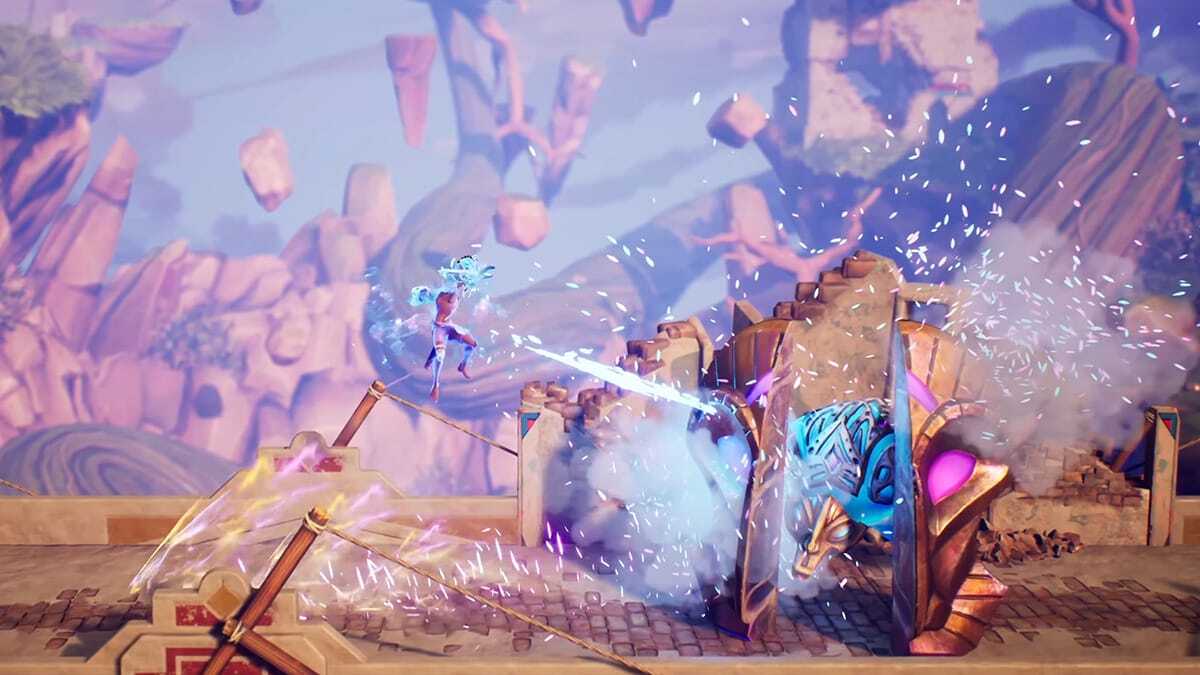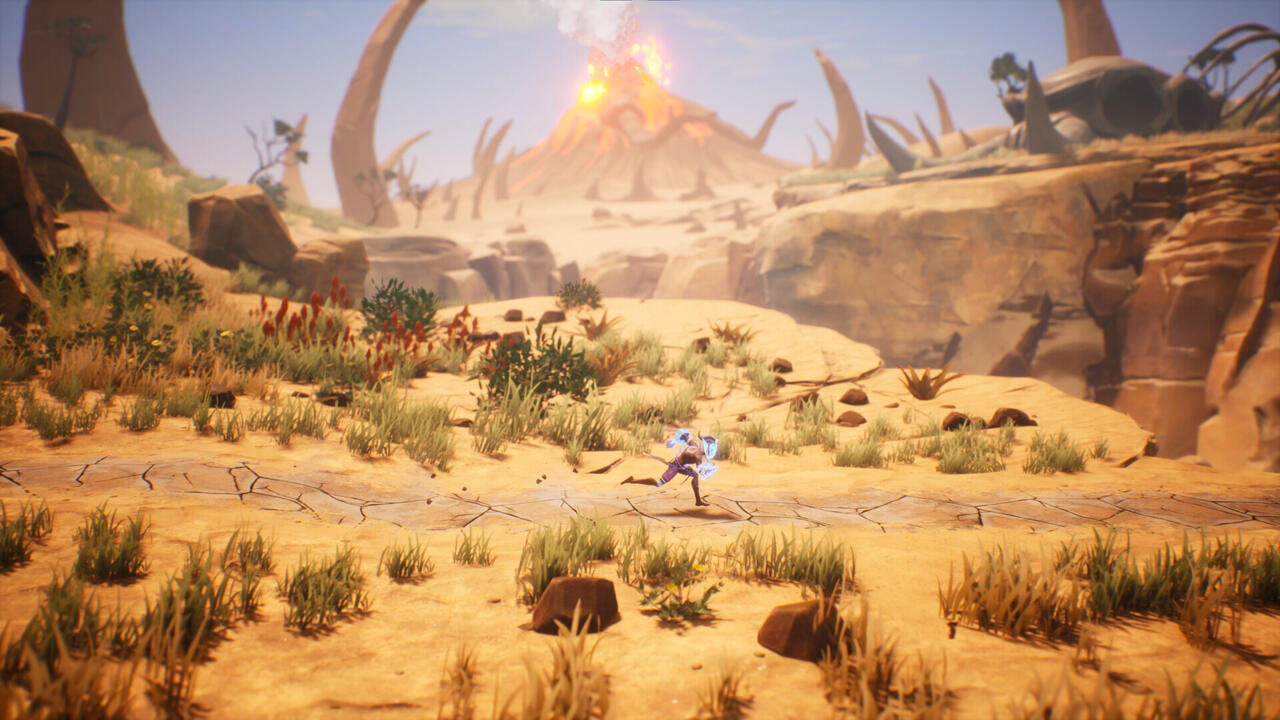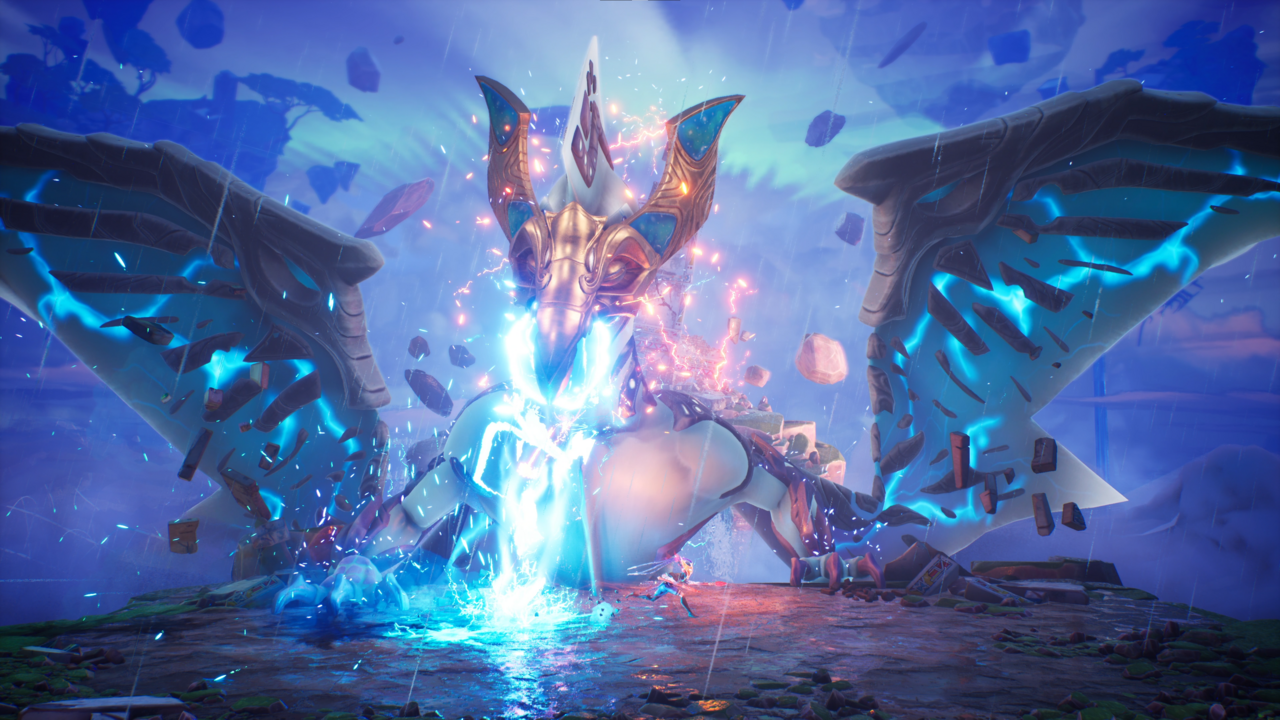Grief is a messy, convoluted emotion to navigate. There's rarely a straightforward path to get through it; oftentimes it can feel like you're walking in circles around what you're looking for, or banging your head against the same mental roadblock again and again. In many ways, the experience of playing through a metroidvania mimics the feeling of working through grief--the genre is built on a similar path of progression, where the necessary tools to move forward are earned step-by-step, and a protagonist's evolving moveset makes it easier to overcome its challenges and navigate a seemingly inescapable world. Tales of Kenzera: Zau leans into that parallel, creating a powerful and moving message within the context of a stellar action-adventure game.
Tales of Kenzera sees you play as Zau, the fictional hero of a story that a father wrote for his son just prior to the father's death. Zau, similarly, is working through the grief of a lost father. Unable to get past the pain, he calls upon the god of death, Kalunga, and offers him a deal: If Zau successfully brings the three great spirits that have resisted Kalunga to the land of the dead, then Kalunga will bring Zau's father back to life. The god agrees and the duo set out, Zau relying on the shaman masks and training he inherited from his father to overcome the dangers of nearby lands. As a metroidvania, the game features moments where Zau must backtrack and use newly unlocked abilities (freezing water, for example, or a grappling hook used to swing over large pits), which Kalunga helps Zau master to navigate the distinct biomes of the map.
Inspired by Bantu mythology, Tales of Kenzera's map is a beautiful maze that pulls from African culture to characterize and flavor the interconnected areas. The myths of the Bantu color the undertones to the story, equating Zau's battle against larger-than-life monsters with a spiritual journey--you don't question how or why Zau's efforts to beat up a mother helps convince her to come to terms with leaving her daughter behind. Within Tales of Kenzera's lore, these actions make sense, reframing the physical space of the world into something more akin to a mental palace. That reframing contributes to the explosive battles, too, with the sound design and orchestral score of the soundtrack transforming each fight into a frenetic dance of emotion and spiritual energy where flame-infused shockwaves are stand-ins for violent outbursts and well-timed dodges equate to a carefully considered counterargument.
Each locale feels distinct from the others, both in color scheme and challenges. The sickly green swamps and massive trees of the forest to the west test Zau's acrobatic abilities, for instance, while the volcanic heat and dry oranges and reds of the desert to the north features plenty of endurance-focused challenges that force Zau to withstand large groups of enemies or solve multi-step environmental puzzles. The structure of these areas interweave with the story, enriching the narrative in rewarding ways. The aforementioned desert sees Zau come to understand that grief isn't something that can be simply overcome--it continues to wash over you in waves, much like the waves of enemies he has to contend with. And sometimes grief can waylay you by showing up in a recognizable but slightly different form, much in the same way the numerous environmental puzzles in the desert region are larger, more convoluted versions of what Zau had to solve in previous areas. We as the player overcome these obstacles alongside Zau working through his pain--he grows as we do, strengthening our connection to his journey.

The mentor/mentee relationship between Kalunga and Zau is front and center throughout, with Kalunga regularly appearing to Zau to provide insight and guidance to the lands' history and culture, as well as to help Zau process his bubbling emotions. Actors Abubakar Salim and Tristan D. Lalla lend incredible gravitas to their respective performances--Salim seamlessly dips back and forth between hot-headed arrogance and barely contained sorrow in voicing the grieving Zau, while Lalla lends a power and authority to Kalunga's fatherly tone. The two characters' growth over the course of the game is surprisingly wholesome despite the dour plotline, making it easy to invest into Zau's development as a shaman.
The other characters in Tales of Kenzera aren't as fleshed out, only appearing a handful of times and always being relegated to narrative devices that tell Zau what macguffin he has to chase after next. The voice acting for these characters is still superb, but the supporting cast--both the humans and the great spirits--is let down by its minimal presence in the story.
The framing device for Zau's story--that this is a story left behind for a grieving boy in the real world--also feels disruptive. Near the end of Zau's adventure, you're abruptly yanked back into the real-world to be reminded of this framing device, which felt incredibly jarring. Zau's story of working through loss was working as a healing experience for me and the game felt the need to stop to explain its own premise, as if it were directly telling me that media can help people overcome grief. And, yes, I know. I was experiencing that sensation. The game broke its own illusion to specifically remind me that it was an illusion, and that lessened the impact of the final moments of Zau's journey. It didn't ruin the ending, but it certainly disrupted the narrative flow leading into Tales of Kenzera's conclusion.

Tales of Kenzera's combat mechanics, however, are fantastic all the way through. Zau can instantly swap between wearing the mask of the sun and the mask of the moon, each granting him different mechanics. The sun mask focuses on melee while the moon mask prioritizes long-range attacks, but the cadence of each bleeds into the other, rewarding you for chaining together the movements of both masks with devastating pirouettes. One of my favorite combos is slamming down into a foe with the summoned spears of the sun mask, switching to the moon mask to blast them away, dashing toward them, and switching back to the sun to hit them with a four-hit melee combo that launches them skyward, giving me a chance to switch back to the moon and juggle them in the air with ranged attacks.
Zau is powerful, but his enemies are numerous, transforming combat into a puzzle where situational awareness trumps power. As such, the game encourages you to dance between targets, overcoming overwhelming odds by being nimble. The movements of both Zau and enemies are sharp and the game makes good use of color--blue and orange for Zau and green and purple for enemies--to keep the fast-paced fights readable. Rarely does it feel like a loss is due to poor luck--the visual clutter of particle effects can become a problem if you're ever standing still long enough for enemies to surround you, but that feels more like a consequence of a mistake on the player's part rather than a detriment of the game itself.
You don't get many upgrades to Zau's combat throughout the adventure. There is a skill tree, but unlocks are geared toward improving existing mechanics--charging the projectiles of the moon mask to unleash a more substantial attack, for instance, or increasing the sun mask's combo chain from three to four strikes. Instead, most of the combat's evolution is based on the enemies that Zau has to fight. You initially only face warriors armed with simple melee attacks or slow-moving projectiles, but you quickly have to take on enemies who shield themselves or fast ball-like foes who willingly explode to take you down with them. And none of them compare to the dastardly fireflies who sap your health to heal other enemies.

Tales of Kenzera's easy opening belies its surprising challenge, especially its tough latter half. There is a difficulty slider that allows you to adjust how much Zau can endure before dying and how much damage he has to deal in order for an enemy to perish, so there is some control in how tough combat is (you can adjust the slider at any time as well, so you won't be punished for accidentally picking a setting too tough or easy at the start). Instant-kill hazards are not affected by difficulty, so there's no way to make traversal challenges easier, but the game is generous with the checkpoints (save for a few exceptions, which we'll get into in a bit), preventing any seemingly insurmountable walls from becoming frustratingly so.
Zau's efforts to pull the great spirits into the realm of the dead culminate in boss battles, and the combat is at its best during these. Most of them see Zau clash with monstrously large beings who are grieving in their own right. Their emotional state informs not only how they fight but what Zau must do in order to get through to them and defeat them. A great spirit overcome with rage angrily lashes out at everything around him, for example, creating huge walls that push out at Zau and threaten to force him off the ledge of the arena unless you use his recently acquired ability to blast through obstacles. This also causes the spirit's own attack to explode and briefly stun him--his anger literally blowing up in his face makes it harder for him to fight you.
The drama and tension of these encounters are amplified by powerful musical scores. I had to step away from Tales of Kenzera and compose myself after battling the great spirit who is overcome with fear, as the escalating rhythm of the score and tension of the string instruments playing through the boss fight made an already stressful fight a more unnerving experience than I expected. The true strength of these fights is how they are emotionally resonant as well as mechanically satisfying--they're the moments when the game is firing on all cylinders, using combat and traversal mechanics, enemy and sound design, and music to emulate one of the more pivotal steps in one boy's struggle with grief. They're all powerful spectacles that I'm still marveling over.

On the other hand, Tales of Kenzera has a few chase sequences that veer toward irritating. These cinematic platforming sections are a common inclusion in the metroidvania genre, a staple that goes back to the original Metroid and Samus' scramble to escape Zebes after killing Mother Brain. In most cases, however, these sequences either afford you a chance to recover from your mistakes (like Metroid) or incorporate numerous autosave checkpoints throughout the section (like Ori and the Will of the Wisps or Hollow Knight). Tales of Kenzera does neither, meaning a mistake usually results in a death that sends you back to the beginning of the sequence, forcing you to redo it over and over. There's a particularly tough sequence near the end of the game where Zau is being chased by something that will kill him instantly, which requires hopping between narrow platforms and over lava that will also kill him instantly to escape. Maybe I'm just getting old, but it took me nearly a dozen attempts to get through that part of the game and by try number seven, I was really frustrated that I had to start over each time.
Thematically, you could say that these sequences emulate working through the fear and anger parts of grief, as both sections deal with the great spirits that embody those emotions, as well as the idea that false starts are an inevitable part of the healing process. And in the same way that there are no save points in working through fear or anger, there are no checkpoints to these platforming sections. That comparison loses value when the rest of the game is hypervigilant about autosaving your progress, however. It's in these moments that there is a conflict between the fun you expect from a metroidvania and the potential desire to convey an emotional state. Tales of Kenzera cleverly blends the two through most of its elements (especially its world and boss design), but falters when it comes to these traversal challenges--the sheer frustration of these platforming do-overs results more in a lack of fun than it summons a sensation of anger or fear. Thankfully, these moments are few and far between, meaning they're only a small irritating blip to what's otherwise a fun game.
Tales of Kenzera: Zau's strength lies in its powerful narrative, digging into how one navigates the sadness, rage, and terror that accompanies the worst moments of grief. Its tale has its hiccups, but Zau's adventure of coming to terms with loss resonates through the beating heart of the thumping musical score, standout vocal performances, and dance-like battles that feel straight out of Bantu myth. Loss is a universal human emotion, making Zau's attempts to grapple with grief uncomfortably relatable. But there's catharsis to be earned in working through that discomfort alongside Zau, and a touching story to enjoy along the way.